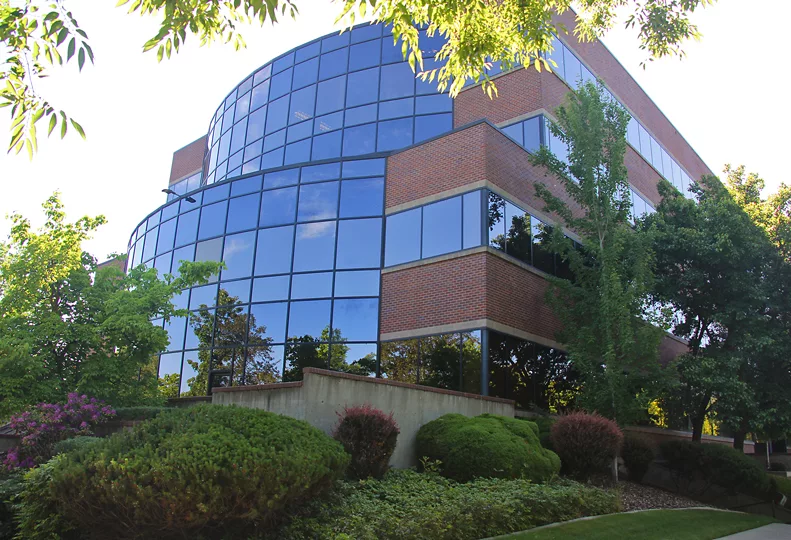
Rates, expectations challenge commercial real estate market
Diverse sector performance shows strong demand in some areas, struggles downtown

Commercial sales are picking up this year at Spokane-based Kiemle Hagood, which handled the $12 million sale of the Riverpoint One building, at 501 N. Riverpoint Blvd., in January.
| Erica BullockCommercial real estate is showing signs of resiliency in the Spokane market despite a steep interest-rate environment, high-priced properties, tariff concerns, and global trade tensions that have been influencing activity in certain sectors, according to some industry observers.
A lack of inventory also is impacting commercial property prices, which haven't come down as much as expected in response to higher interest rates, says Casey Brazil, vice president and chief operating officer at Spokane-based commercial brokerage Kiemle Hagood.
"As interest rates went up, you would think that prices would start to drop ... but it hasn't," says Brazil. "Prices aren't coming down because you don't have a bunch of other product being built for people to purchase or occupy."
The Federal Reserve has kept interest rates steady at a 4.25%-4.5% range, following the most recent cuts in late 2024, according to the May 2025 Commercial Real Estate Market Insights Report by the National Association of Realtors.
Federal interest rates influence economic activity and serve as a benchmark for other interest rates, such as those for commercial loans. While interest rates for commercial properties can be influenced by federal rates, they are also determined by legislative or executive action and market conditions, so they aren't directly mirroring federal rates.
Current interest rates for commercial real estate loans in the Spokane market range between 6.5% and 7%, says Brazil, adding that the high cost of borrowing has been challenging for transactions as higher capitalization rates—the estimated return on an investment based on the property's net income compared to its sales price—are needed for investors to gain positive leverage.
Cap rates and property values are inversely related, in that as cap rates increase, property values tend to decrease. Historically, Spokane’s cap rates have been between 6% and 7%. But in 2021, for example, when interest rates were lower, cap rates ranged between 4% and 5%, resulting in high-valued properties.
James Black III, senior investment advisor at Spokane-based NAI Black, says cap rates need to increase for investors to achieve a positive return when borrowing money.
Brazil concurs and adds that a healthy market has spread of 1.5% to 2% between loan rates and cap rates.
Buyer-seller disconnect
When factoring in the cost to service a loan, a buyer with a loan at 6.5% interest would need about an 8% cap rate or better for positive leverage, explains Black. However, he says finding deals with such high cap rates is "tough to clearly find these days" because sellers' price expectations are still somewhat influenced by previous market conditions when money was cheaper and property values were higher a few years ago.
There's a growing separation between what sellers and buyers expect in the market.
"There's definitely been a disconnect between sellers' expectations and what buyers can essentially afford to pay, if they're going to borrow money," says Black.
Both Brazil and Black say alternative financial solutions are becoming more common to help address higher financing costs, as sellers can reach their asking price while buyers can purchase at a lower interest rate than traditional banks would typically offer.
"We've seen some movement on buildings where people have slowly started to lower their price to sell that property," says Brazil. "But we've also seen what's happened is there's been more owner contracts now. ... For investment deals that are occurring, there's a lot more cash down if they're taking out financing, or they're 100% cash deals."
Investors are seeking good deals in the market or distressed properties that can provide more value to buyers, Black says.
Despite the challenges, Brazil says the commercial real estate market in the Spokane area "looks decent."
Market conditions are also impacting the types of transaction activity happening in the Spokane area.
At Kiemle Hagood this year, sales have been picking up after an estimated 50% reduction in 2024, Brazil says.
"Last year, we had more transactions, but more leasing compared to sales. This year, we've seen sales pick up compared to leasing," says Brazil. "In general, it's been a very active market. From a brokerage standpoint, we're trending much higher than we were in 2024."
In January, Kiemle Hagood handled the sale of the Riverpoint One building, at 501 N. Riverpoint Blvd., which Spokane Colleges sold for $12 million to Spokane Public Schools.
NAI Black has also had a successful start to the year supported by a mix of leasing, subleasing, and sale transactions, Black says.
In February, Black handled the sale of the 58-unit Union Park Apartments, at 18 and 28 W. Second in Cheney, that sold for $5 million with a 6% cap rate, he says.
"Our company is doing phenomenal ... so my glass is half full," says Black.
Local, national performance
Nationally, new inventory is outpacing absorption for multifamily, retail, and industrial properties, contributing to higher vacancies in each sector, according to the National Association of Realtors market insights report. Office demand also is lagging, contributing to a record-high vacancy rate of 14% with about 1% rent growth.
In the Spokane market, challenges persist for office properties in downtown Spokane, due to high vacancy rates, public safety concerns, limited parking, fewer people working downtown, and stagnant rent growth, both Brazil and Black say.
Demand for office buildings is stronger on the periphery and in outlying submarkets, such as Liberty Lake, North Spokane, and the South Hill, Brazil says. While some downtown properties are being converted to residential use, which could potentially help the office market by taking that inventory offline, the impact on demand at this time is unclear.
Office vacancy rates in the Central Business District are about 28%, according to the 2025 Market Review & Outlook report by Kiemle Hagood.
Some national tenant bankruptcies are contributing to a cooling retail sector nationwide, but in the Spokane area, there are new tenants entering the market that are creating competition for prime tenant spaces, Black explains.
Notably, in the city of Spokane Valley, Brazil says retail vacancies have significantly improved over the last 10-15 years, dropping from 12%-15% to around 4%-5% currently, which is considered a healthy market. Downtown Spokane retail, however, is struggling as it relies heavily on daytime office occupancy, he says.
After booming in 2022, the industrial real estate sector is now dealing with an excess of supply and a decline in demand, according to the national Realtors report. Between April 2024 and April 2025, net absorption declined by 22% nationwide, while new deliveries outpaced absorption by a 3-to-1 margin.
Large industrial properties in the Spokane market are "not doing very well" with several million square feet available, Black says.
The multifamily market is stabilizing with modest rent growth of 1.1% and steady vacancy rates of 8% across the country, information in the Realtors report shows. While in the Spokane multifamily market, strong development activity has created an influx of inventory, and investors are not showing as much interest as they previously were, says Brazil.
Recently, Black and Brazil say separately that they've noticed changing demographics toward a more balanced investor market, featuring both local investors and those from outside markets, such as Seattle, Portland, and California.
"This year, for sure, I've had more local investors than in prior years. And I think that has a lot to do with rates," says Black. "It has kind of evened the playing field to some extent."
Despite challenges in certain sectors and the market uncertainty brought on by federal trade policy and tariff announcements, Brazil says the overall market outlook for the area is showing signs of improvement—if at least for the next 30 days.
"Where we used to be able to say the rest of the year looks really good, I'm probably looking at it from every 30 days ... from the question of tariffs and how that affects us locally," says Brazil. "Some of our clients businesses can be affected by those tariffs depending on what product they're selling, where they're getting that product, and all of it's interrelated."
Black adds that commercial real estate market fluctuations are to be expected.
"Real estate is cyclical, so I'm cautiously optimistic," says Black.



_web.webp?t=1764835652)
